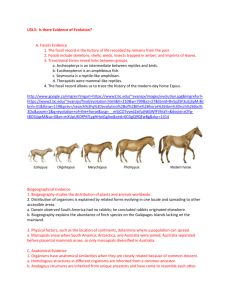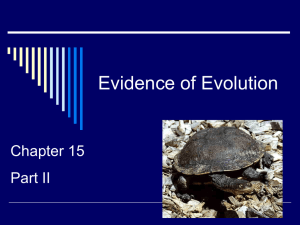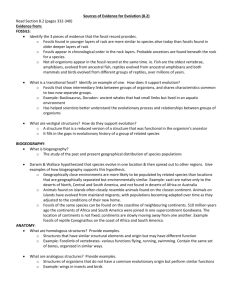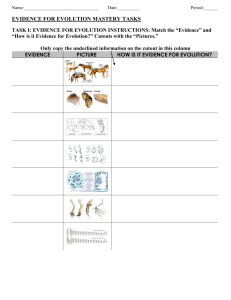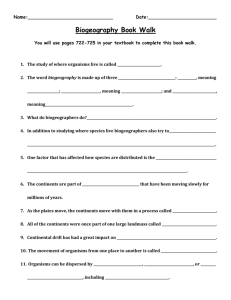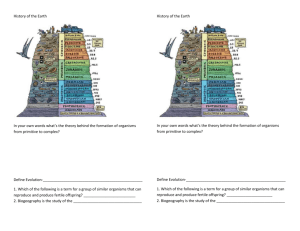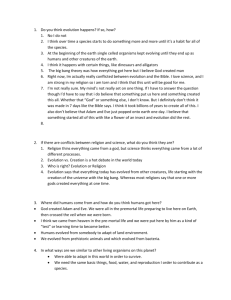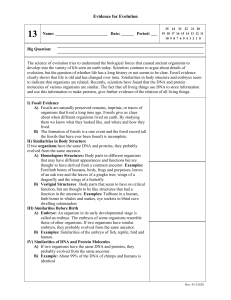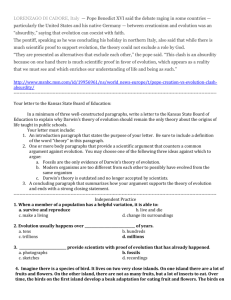Ch. 4.1 notes continued
advertisement
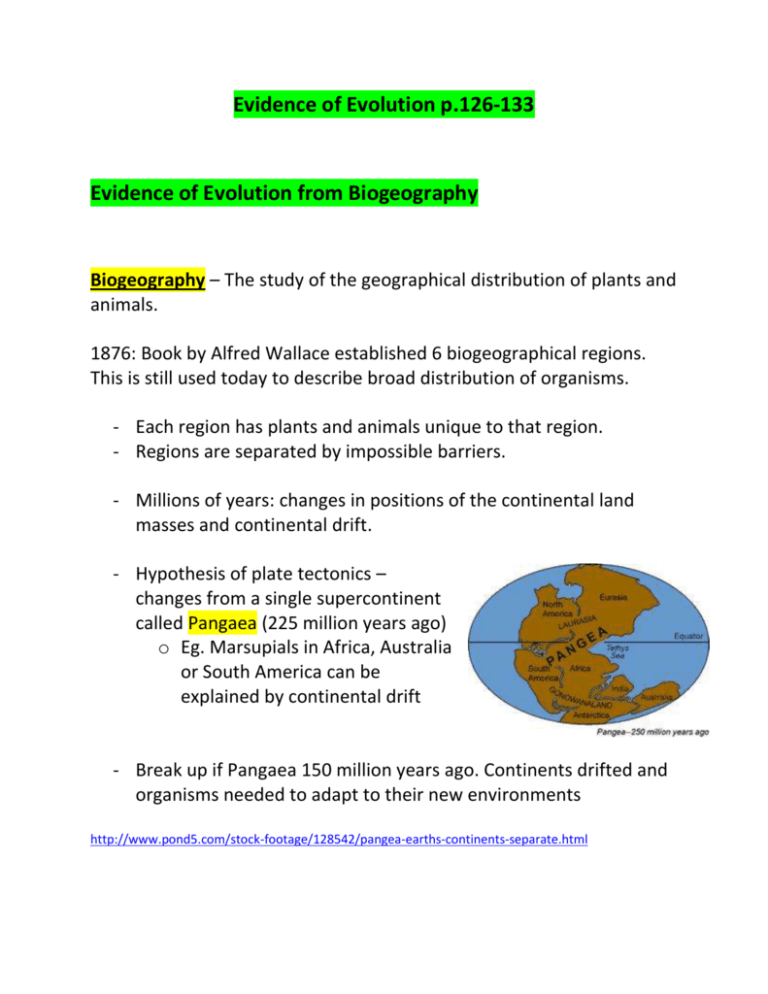
Evidence of Evolution p.126-133 Evidence of Evolution from Biogeography Biogeography – The study of the geographical distribution of plants and animals. 1876: Book by Alfred Wallace established 6 biogeographical regions. This is still used today to describe broad distribution of organisms. - Each region has plants and animals unique to that region. - Regions are separated by impossible barriers. - Millions of years: changes in positions of the continental land masses and continental drift. - Hypothesis of plate tectonics – changes from a single supercontinent called Pangaea (225 million years ago) o Eg. Marsupials in Africa, Australia or South America can be explained by continental drift - Break up if Pangaea 150 million years ago. Continents drifted and organisms needed to adapt to their new environments http://www.pond5.com/stock-footage/128542/pangea-earths-continents-separate.html - Convergent evolution: development of similar forms from unrelated species due to adaptation to similar environments. - Differences between amphibians and reptiles can be explained by biogeography o Amphibians and reptiles around at the time of Pangaea, and all distributed on other continents. They evolved after the breakup of the continent. http://www.youtube.com/watch?v=2NglfGlYaJo&feature=related Mammals did not appear until after Pangaea split, making mammals on each continent unique Continents with similar or same animals can be explained by land bridges (narrow strips of land that connects some continents) Remote islands are homes to unique species, many of which are endemic (found nowhere else). This suggests that these species have evolved in isolation. These animals do resemble animals found on the closest continent. This suggests that animals on islands evolved from mainland migrants, with populations becoming adapted over time as they adjust to the environmental conditions of their new homes. Evidence from biogeography suggests that different species evolved independently in isolated parts of the world. Evidence of Evolution from Vestigial Features Vestigial features provide evidence of specific changes. Vestigial features are rudimentary structures that serve no useful function. These features once served a function in an ancient ancestor. Whales and snakes have vestigial hip and leg bones – evidence that suggests that they evolved from ancestors that walked on four limbs. http://www.podcast.tv/video-episodes/vestigial-organs-wings-of-the-flightless-cormorantfeaturing-richard-dawkins-8758278.html Evidence of Evolution from Transitional Fossils The original fossil record gave scattered “snapshots” of ancestral forms, and critics of the theory were concerned about the “gaps” Transitional fossils link the past to the present. Hundreds of transitional fossils have now been found. Transitional fossils are the remains or impression of a prehistoric organism that shows intermediary links between groups of organisms and shares characteristics common to these groups. Evidence of Evolution from Anatomy - Homologous Structures – body parts in different species that have the same evolutionary origin and structural elements but may have a different function. o Ex. Bat wing, human arm, dolphin flipper, horse leg. Their limbs have similar structures, such as the number of bones, muscles, ligaments and tendons. However, the structural elements are arranged to be best suited for different functions. Similar because they were inherited from a common ancestor. Note: Functional similarity in anatomy, however, does not necessarily mean that species are closely related. - Analogous Structures – body parts in different species that have a similar function but evolved separately. o Bird wing (bones support wings) vs. insect wing (wings made of chitin). These organisms evolved independently of one another and do not share a common ancestor with wings. Evidence from Embryology - The embryos of different organisms exhibit similar stages of embryonic development. - All vertebrate embryos have paired pouches, or out-pocketings of the throat. o In fish and some amphibians, the pouches develop into gills. o In humans, the pouches become part of the ears and throat. - The similarities among embryos in related groups (such as vertebrates) point to a common ancestral origin. Evidence from Biochemistry & Molecular Biology All cells consist of membranes filled with water, genetic material, proteins, lipids, and carbohydrates. Proteins called enzymes control biochemical reactions in all organisms. In all organisms, proteins are synthesized from amino acids. In all organisms, all cells that can replicate contain DNA. Since DNA carries genetic information, scientists can determine how closely related two organisms are by comparing their DNA. If two species have similar patterns in portions of their DNA, this would indicate that these portions of their DNA were most likely inherited from a recent common ancestor. Evidence from Genetics Scientists now know how species pass on their traits to their offspring, and how the blueprints (genes) for these traits could change by mutation. Current evolutionary theory connects genetics with the theory of natural selection, and how natural selection operates on populations. Evidence from Artificial Selection Humans can use artificial selection to produce dramatic changes in species over relatively short periods of time. Provides evidence that similar and even more dramatic changes occur in nature over millions of years and countless generations. Assignment: P. 133 #’s 2-8 & 10
